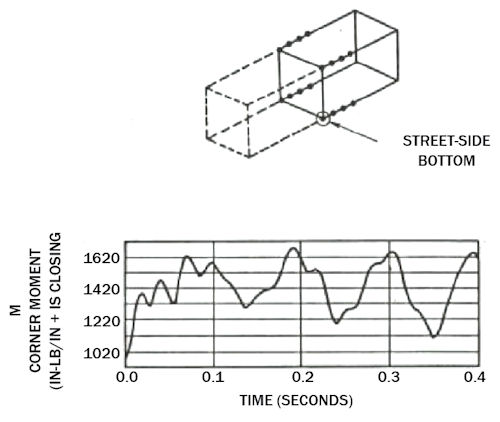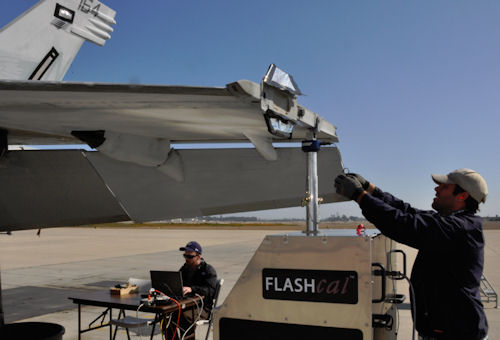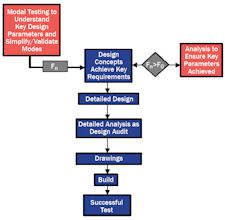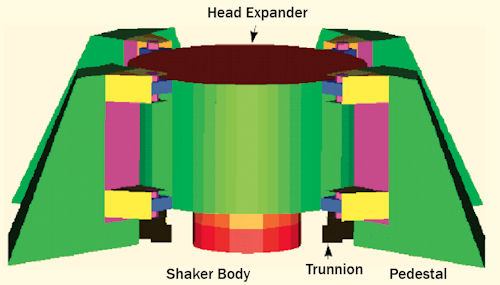Physical Testing is Still Vitally Important
While simulation has an increasingly large role, real-world tests at the right points can save time and money--while minimizing problems.
Latest News
October 1, 2012
By Bill Schweber
Today’s advanced simulation capabilities can eliminate the need for many physical tests. But they can also lead to overconfidence and grossly incorrect results, which add to cost, schedule and performance issues.
This is not a new situation; it’s really an updated embodiment of the “garbage in, garbage out” (GIGO) software principle. The numerical precision for which computers and algorithms are so well suited is not a substitute for verifying critical assumptions and parameter values of the simulation, and in fact, such precision can induce false confidence and unpleasant surprises. Looking at it another way, it’s like having 10 significant figures on your results, although your raw experimental data was only accurate to two digits. |
| Fig. 1: When validating a military command, control, communications and intelligence system shelter design for nuclear blast survivability, testing proved the corner welds would remain intact at their weakest point on the long side of the shelter. |
Driving Better Design
There’s a downside to placing too much reliance on design by analysis and simulation, without the right injections of design by test at critical junctions in the program. Every analysis and associated simulation incorporates many assumptions about system parameters and dynamics. Some of these assumptions are fairly solid, and come with a high level of confidence. But many others may be well intentioned but wrong, or little more than sophisticated guesses. Of course, it’s one thing if you are doing analysis and simulation on well-known and fully characterized materials and designs, such as metal structural elements and conventional joints, whose properties and attributes are long-established and understood. It’s a very different situation when you venture into new areas such as components and complex joints made of composite materials or joining composites and metals. |
| The FlashCal system is a piece of hardware developed by ATA engineers for the calibration of aircraft strain sensors. |
Targeting the Cost of Testing a Design You hear it over and over: Simulation saves money, and doing design by analysis and simulation is cheaper and quicker than doing it via developmental tests. Well, yes and no. Certainly, for some project areas, such as in aerospace, testing is a major undertaking. But as simulation advances in capabilities and corresponding expectations, and increasingly employs multiphysics to combine disciplines into one overall model (electrical, mechanical and thermal aspects, for example), the cost and time of such analytical cycles and runs increases as well. Further, the model is charged with integrating so many functions and roles that it can become unwieldy in construction, degrees of freedom, and implementation. At the same time, such models embed a large number of assumptions, all of which will have a ripple effect as they propagate through the simulation. That’s why a carefully targeted developmental test can be a vital part of the design, simulation and modeling process. It can both simplify some aspects of the model “replacing complex equations with simplified ones or actual data “and it can reduce the uncertainties that accompany many assumptions, thus increasing overall level of confidence. |
 |
| Fig.2: By testing specific areas of uncertainty first, you can direct component-design specifications toward outcomes with a higher likelihood of success. In this example of satellite testing on a shake-table, Fn = Shaker system’s lowest natural frequency; Fo= Satellite target mode frequencies. |
Can We Talk?
It’s important for the analysis and test teams to talk early and often. While this may seem obvious, Baker notes than in many companies, they are actually separate and isolated groups. As a result, the analysis group may not cite the areas where they are making assumptions for which they do not have a firm basis or high confidence. In contrast, when there is team overlap and integration, the test engineers can question assumptions early in the cycle “and also suggest specific, limited-scope tests to verify these assumptions, or provide better data so the simulation can continue with a higher degree of confidence.
Shaken, Not Stirred To properly evaluate the satellite in a combined modal and qualification test, the first natural frequency of the shake table (shaker) must be higher than the target-mode natural frequencies of the satellite itself. In addition, the shaker’s cross-axis coupling and need for uniform excitation level dictate a very light, yet stiff shaker structure. The standard approach of design, analyze, build and test would eventually work, but likely require many iterations. At the same time, using this procedure may have other negative consequences. Developing the detailed finite element analysis (FEA) models takes time, which is counter to investigating design change and larger innovations.
Rather than begin the new design, in this application, engineers first did a modal test on the existing system, and a simple FEA model to represent the dynamics of the primary modes. The test verified the simple model, and the results were used to direct the new design by providing bearing stiffness data that was hard to predict by analytical means alone. Fig. 2 on page 34 shows this design approach, which differs from the usual design/test/redesign approach. The tests also showed that the head expander of the shaker controlled the lowest natural frequency and cross-axis coupling. As a consequence, designers realized that this head expander would need a high stiffness-to mass ratio. To achieve this, they used a magnesium weldment, which allows the head expander to move vertically via eight bearings (see image above). The outsides of the bearings, in turn, are supported by steel “pedestals” for stiffness, but because these pedestals are static and not part of the moving structure, their weight is not a concern. |
Bill Schweber is an engineer with electronic and mechanical design experience. He can be reached at [email protected].
More Info
ATA Engineering Inc.Subscribe to our FREE magazine, FREE email newsletters or both!
Latest News
About the Author
DE’s editors contribute news and new product announcements to Digital Engineering.
Press releases may be sent to them via [email protected].






